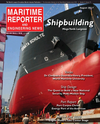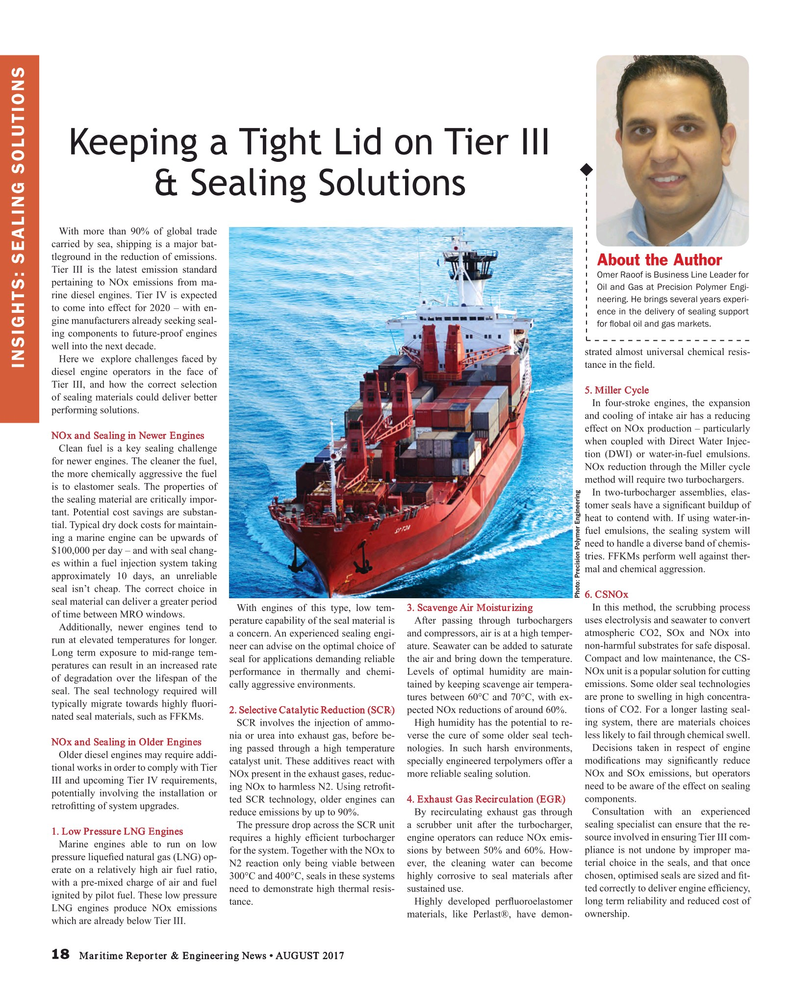
Page 18: of Maritime Reporter Magazine (August 2017)
The Shipyard Edition
Read this page in Pdf, Flash or Html5 edition of August 2017 Maritime Reporter Magazine
Keeping a Tight Lid on Tier III & Sealing Solutions
With more than 90% of global trade carried by sea, shipping is a major bat- tleground in the reduction of emissions.
About the Author
Tier III is the latest emission standard
Omer Raoof is Business Line Leader for pertaining to NOx emissions from ma-
Oil and Gas at Precision Polymer Engi- rine diesel engines. Tier IV is expected neering. He brings several years experi- to come into effect for 2020 – with en- ence in the delivery of sealing support gine manufacturers already seeking seal- for ? obal oil and gas markets.
ing components to future-proof engines well into the next decade.
strated almost universal chemical resis-
Here we explore challenges faced by tance in the ? eld.
INSIGHTS: SEALING SOLUTIONS diesel engine operators in the face of
Tier III, and how the correct selection 5. Miller Cycle of sealing materials could deliver better
In four-stroke engines, the expansion performing solutions.
and cooling of intake air has a reducing effect on NOx production – particularly
NOx and Sealing in Newer Engines when coupled with Direct Water Injec-
Clean fuel is a key sealing challenge tion (DWI) or water-in-fuel emulsions. for newer engines. The cleaner the fuel,
NOx reduction through the Miller cycle the more chemically aggressive the fuel method will require two turbochargers.
is to elastomer seals. The properties of
In two-turbocharger assemblies, elas- the sealing material are critically impor- tomer seals have a signi? cant buildup of tant. Potential cost savings are substan- heat to contend with. If using water-in- tial. Typical dry dock costs for maintain- fuel emulsions, the sealing system will ing a marine engine can be upwards of need to handle a diverse band of chemis- $100,000 per day – and with seal chang- tries. FFKMs perform well against ther- es within a fuel injection system taking mal and chemical aggression.
approximately 10 days, an unreliable seal isn’t cheap. The correct choice in 6. CSNOx
Photo: Precision Polymer Engineering seal material can deliver a greater period
With engines of this type, low tem- 3. Scavenge Air Moisturizing In this method, the scrubbing process of time between MRO windows.
Additionally, newer engines tend to perature capability of the seal material is After passing through turbochargers uses electrolysis and seawater to convert a concern. An experienced sealing engi- and compressors, air is at a high temper- atmospheric CO2, SOx and NOx into run at elevated temperatures for longer. neer can advise on the optimal choice of ature. Seawater can be added to saturate non-harmful substrates for safe disposal.
Long term exposure to mid-range tem- seal for applications demanding reliable the air and bring down the temperature. Compact and low maintenance, the CS- peratures can result in an increased rate performance in thermally and chemi- Levels of optimal humidity are main- NOx unit is a popular solution for cutting of degradation over the lifespan of the cally aggressive environments. tained by keeping scavenge air tempera- emissions. Some older seal technologies seal. The seal technology required will tures between 60°C and 70°C, with ex- are prone to swelling in high concentra- typically migrate towards highly ? uori- 2. Selective Catalytic Reduction (SCR) pected NOx reductions of around 60%. tions of CO2. For a longer lasting seal- nated seal materials, such as FFKMs.
SCR involves the injection of ammo- High humidity has the potential to re- ing system, there are materials choices nia or urea into exhaust gas, before be- verse the cure of some older seal tech- less likely to fail through chemical swell.
NOx and Sealing in Older Engines ing passed through a high temperature nologies. In such harsh environments, Decisions taken in respect of engine
Older diesel engines may require addi- catalyst unit. These additives react with specially engineered terpolymers offer a modi? cations may signi? cantly reduce tional works in order to comply with Tier
NOx present in the exhaust gases, reduc- more reliable sealing solution. NOx and SOx emissions, but operators
III and upcoming Tier IV requirements, ing NOx to harmless N2. Using retro? t- need to be aware of the effect on sealing potentially involving the installation or ted SCR technology, older engines can 4. Exhaust Gas Recirculation (EGR) components. retro? tting of system upgrades.
reduce emissions by up to 90%. By recirculating exhaust gas through Consultation with an experienced
The pressure drop across the SCR unit a scrubber unit after the turbocharger, sealing specialist can ensure that the re- 1. Low Pressure LNG Engines
Marine engines able to run on low requires a highly ef? cient turbocharger engine operators can reduce NOx emis- source involved in ensuring Tier III com- for the system. Together with the NOx to sions by between 50% and 60%. How- pliance is not undone by improper ma- pressure lique? ed natural gas (LNG) op-
N2 reaction only being viable between ever, the cleaning water can become terial choice in the seals, and that once erate on a relatively high air fuel ratio, 300°C and 400°C, seals in these systems highly corrosive to seal materials after chosen, optimised seals are sized and ? t- with a pre-mixed charge of air and fuel need to demonstrate high thermal resis- sustained use. ted correctly to deliver engine ef? ciency, ignited by pilot fuel. These low pressure
LNG engines produce NOx emissions tance. Highly developed per? uoroelastomer long term reliability and reduced cost of materials, like Perlast®, have demon- ownership.
which are already below Tier III.
18 Maritime Reporter & Engineering News • AUGUST 2017
MR #8 (18-25).indd 18 MR #8 (18-25).indd 18 8/4/2017 10:16:02 AM8/4/2017 10:16:02 AM

 17
17

 19
19
